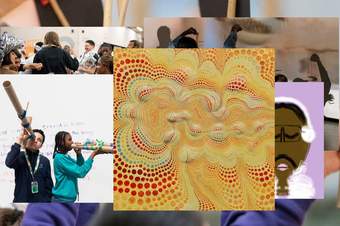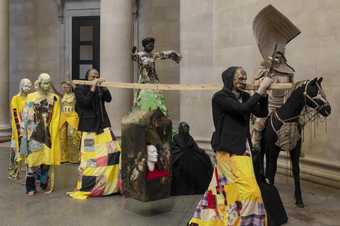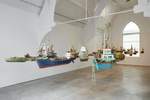
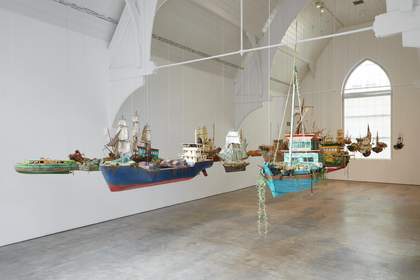
Hew Locke
Be inspired by artist Hew Locke and make your own painting that explores your stories of journey and movement
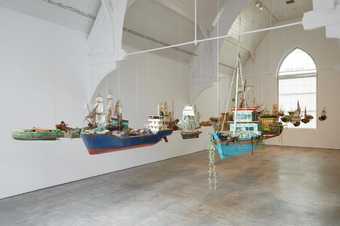
Hew Locke
Armada (2017–2019)
Tate
Your students don’t need to know anything about an artwork or artist to start exploring it.
Use these quick group activities to build their confidence and curiosity in sharing their first responses to the artwork. Some artworks they might like straight away, some they might not.
Discovering art can be new, exciting and sometimes confusing. There are no right or wrong ways to respond!
In pairs or as a group, take it in turns to imagine the artworks answering these questions and telling their story.
- What are you made from?
- When were you made?
- What has happened here?
- Do you want me to feel sad or joyful, or something else?
- What else would you like to say?
In pairs or as a group, use your body to respond to the artwork.
- Mirror movements or shapes in the artwork
- Imagine sounds the artwork might make
- Trace the artwork in the air with your hands
- Move like the artwork
- What else could you do?
About the artwork
Armada 2017–19 is an installation of 45 boats made by Hew Locke. The flotilla hangs from the ceiling at shoulder height and includes boats from different times and places. There are miniature cargo ships, fishing boats, caravels, galleons and more.
Each boat is made from and decorated with a variety of materials. Some boats feature plastic toys and mass-produced decorative elements; others incorporate materials that speak to histories of migration and colonisation, including jewels, military badges and replica medals, as well as coins from the Caribbean, Gambia, Syria and other formerly colonised areas of the Global South. Collectively, these elements suggest themes such as international trade, the movement of people and the current global refugee crisis.
Hew Locke is a sculptor and visual artist, who was born in Edinburgh and moved to Guyana as a child, spending his formative years there. He later travelled back to Britain as part of the post-Windrush Generation, going on to study and work as an artist in the UK.
Make
Armada prompts us to think about where each boat in this artwork might be coming from, and where it’s journeying to. In this activity, imagine yourself as a boat containing stories of where you have been and where you would like to be going.
- Think about any boats you have seen – these could be real boats that you’ve travelled on, or boats from history, films or books.
- Draw a boat onto your sheet of card or paper and cut it out. On one side, spend some time answering the questions below. Write however you like – around the edges, in any direction or upside down. Try writing small so people have to really study your artwork to find its meaning!
ADAPT
Make your boats in 3D! Use pre-cut triangles of card for the sails and personalise these using mark-making, gesture or by sticking beads, fabric or other materials to them.
Now use playdough or modelling clay to mould your boats. Glue the sails onto lolly sticks and stick them into your boats.
Look at your boats together and share your stories!
- Tell a story about you when you were younger: share an experience, describe your family or write about moving country or house.
- Describe a journey you have been on – where did you start from and where did you go?
- Now add a dream about your future self. What would you like to do or become?
3. Use paint to decorate your boat on the other side. Be bold.
4. Try adding in other materials as Locke does. Add a bit of PVA glue into your paint and then stick beads, lentils, collage, rice, sequins, coloured paper, wool, or anything else to your boat.
5. At the end of your lesson, bring all of your boats to the front of your classroom and look at them together. Find each other’s stories and celebrate the artwork you’ve just made!
What have you learned by experimenting with materials and storytelling?
What do the materials you chose represent to you?
Extend
Make a class display of all of your boats. If you are feeling ambitious, try suspending your flotilla from the ceiling. Alternatively try hanging them in a window so that both sides of your display can be enjoyed. You could also display your collective journey travelling one way (painted side) and then the other (written side).
In pairs, choose a boat that isn’t yours and read what has been written on it. On a sheet of A4 paper, note down the maker’s future dream, then fold the paper into a paper aeroplane. Take turns launching your paper aeroplanes. As you launch, speak out the dream to create a collective statement for the future.
How to use art makes
Making art is a powerful way to learn new skills, explore ideas and express ourselves creatively. Encourage your students to discover new materials, techniques and methods inspired by great artists at Tate.
- Prepare
- Project the artwork in your classroom and/or print off copies for your students to have in front of them.
2. Explore (10 minutes)
- Invite your students to respond to the artwork through the group activity.
- Read the background information on the artwork.
3. Make (30 minutes)
- Follow the step-by-step instructions.
- Use the Adapt section for accessible alternatives to this activity.
- Use the Extend activity within the same lesson or in a future session.

